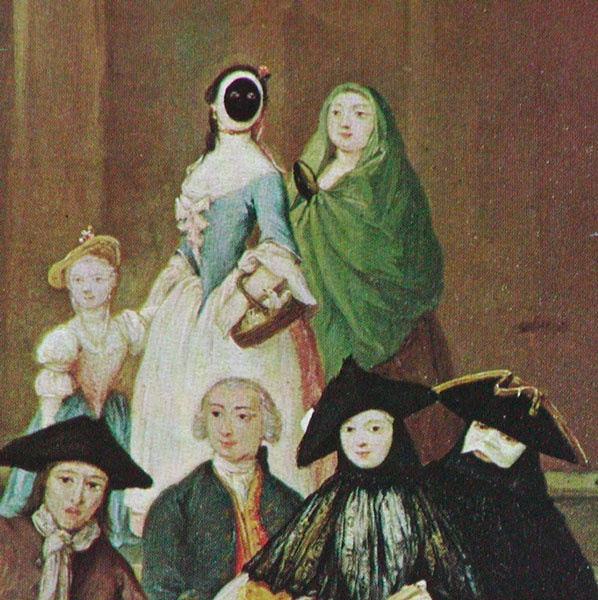 |
The moretta mask: Venetian mask of seductionThe moretta mask, reserved exclusively for women, was a Venetian mask that was round and covered with black velvet. Also known as the 'muta', it perfectly concealed the features of the wearer's face and was very common in Venice in the 18th century.
|
Covering one's face in order to appear more attractive ('visible') may seem like a contradiction, but it was not so according to the special logic of Venetian women. These women were rather disinhibited in showing their bodies, as evidenced by the fashion called “décolleté alla veneziana”, famous throughout Europe. It featured a very generous, square neckline. The breast was veiled in a light fabric, which covered the chest precariously. It was also common to put makeup on the nipples with carmine red so as to make them more 'visible' behind the transparent fabric.
If what was on display was meant to attract attention, what was hidden behind the moretta was regarded as the true treasure to be discovered: their inner world, their intentions and feelings.
But one shouldn't misunderstand: with the moretta, women did not only express an innocent desire to be seen but much more mischievously, to be powerfully seductive. They were openly playing the game of seduction as it was played across Venice.
The origin and meaning of the name 'moretta'
The term 'moretta' derives from the adjective 'moro', which means dark, and thus explains how the moretta mask would always be covered in black velvet. |
The moretta was held close to the face without the use of laces, but by biting between the teeth a button just at the level of the mouth. A lady who wanted to wear the moretta, therefore, had to remain completely silent. The use of the moretta mask contributed to the fascination with the mysterious use of masks in Venetian life. It should not be confused with the desire of men to hide the features of women from the eyes of others. Covering her face with a moretta, the mask of seduction, and staying silent at the same time, a lady's intentions were completely indecipherable. |
And so it was the woman herself who decided whether she remained anonymous and silent or whether she decided to respond to the attention, if not the advances, of some suitor. Removing the moretta mask, the lady offered not only the longed-for sight of her face but also the sound of her voice, considered a faithful mirror of the soul. Only the truly fortunate had the privilege to admire that face and to hear her voice, but it would have taken a brave man to seduce a woman without knowing what he was getting - as well as bold since he would have had to convince her to reveal her secret. |
 |
La moretta: dalla pratica quotidiana all'oblio
|
Take a look at our online shop webpage. It is dedicated to traditional Venetian masks. There you can see the moretta - the great Venetian mask of seduction - presented in detail.